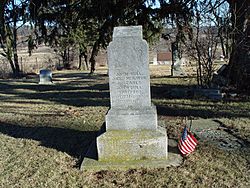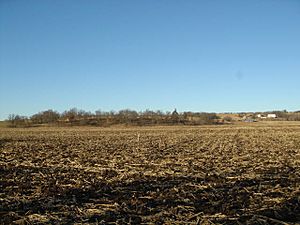Spafford Farm massacre facts for kids
Quick facts for kids Spafford Farm Massacre |
|||||||
|---|---|---|---|---|---|---|---|
| Part of the Black Hawk War | |||||||
 Monument near South Wayne, Wisconsin. |
|||||||
|
|||||||
| Belligerents | |||||||
| Kickapoo; those aligned with Black Hawk's British Band | |||||||
| Strength | |||||||
| 6 | unknown | ||||||
| Casualties and losses | |||||||
| 4 killed | 1 killed | ||||||
The Spafford Farm attack, also known as the Wayne attack, was a violent event during the Black Hawk War. It happened on June 14, 1832, near what is now South Wayne, Wisconsin. Omri Spafford and Francis Spencer had settled Spafford Farm in 1830. They had made many improvements to their land. On the day of the attack, five men were targeted by a group of Kickapoo warriors. Three white settlers, including Spafford, were killed right away. In total, four white settlers and at least one Native American warrior died. Two men managed to escape. This event at Spafford Farm later led to the Battle of Horseshoe Bend.
Contents
What Led to the Black Hawk War?
In 1804, a treaty was signed between the governor of Indiana Territory and some Sauk and Fox leaders. This treaty was about land settlement. Because of it, the Sauk and Fox tribes left their lands in Illinois in 1828. They moved west of the Mississippi River.
However, a Sauk leader named Black Hawk and others disagreed with the treaty. They said that the full tribal councils were not asked. They also claimed that the leaders who signed it did not have the right to give away the land. Black Hawk was upset about losing his birthplace. Starting in 1830, he led his group, called the "British Band", across the Mississippi River several times. Each time, he was convinced to go back without any fighting.
In April 1832, Black Hawk moved his band of about 1,000 warriors and civilians into Illinois again. He hoped other tribes and the British would join him. But he found no allies. He then tried to return to Iowa. However, events unfolded quickly, leading to the Battle of Stillman's Run. More battles followed, and the state militias of Wisconsin and Illinois were called to find Black Hawk's band. This conflict became known as the Black Hawk War.
Preparing for the Attack
| Map of Black Hawk War sites Symbols are wikilinked to article |
The Spafford Farm attack happened in Lafayette County, Wisconsin, near what is now South Wayne, Wisconsin. It took place during the Black Hawk War. Omri Spafford and Francis Spencer made the first land claim in Lafayette County in 1830. Spafford Farm was located near where Spafford's Branch met the Pecatonica River. Before the war started in 1832, they made many improvements to the land.
On the day of the attack, six men were at Spafford Farm. These men were Omri Spafford, Francis Spencer, Bennett Million, Abraham Searles, James McIllwaine, and an Englishman known only as "John Bull" (who was likely John Compton).
The Attack Happens
On June 14, 1832, the six men were sent from Fort Hamilton to work at Spafford Farm. They had just started working when a group of Kickapoo warriors attacked them. The warriors had hidden in trees near the farm. They opened fire in a surprise attack.
The men dropped their tools and ran towards the Pecatonica River. They quickly crossed the river. As four of the men climbed up the opposite bank, they were shot. Spafford, Searles, and McIllwaine were killed instantly. "Bull" (John Compton) was also killed.
Spencer and 17-year-old Million managed to escape the attackers. Million escaped by jumping into the Pecatonica River. He hid in the brush and then made his way to Fort Hamilton. Spencer's escape took longer. He did not jump into the river but hid along its banks. One of the attackers chased him, but Spencer killed the warrior before he could be caught. Spencer then wandered in the woods for several days. He finally reached Fort Hamilton.
Spencer arrived at Fort Hamilton around the same time that Colonel William S. Hamilton came with a large group of Menominee people. The Menominee had volunteered to fight against the Sauk and Fox. Spencer was afraid that the fort had also been attacked. So, he went back into the woods. He avoided the fort for about six to nine days. Hunger finally made him come out into the open, and he realized his mistake.
What Happened Next?
News of the attack at Spafford's farm quickly reached Fort Defiance. This fort was about five miles southeast of Mineral Point, Wisconsin. A small group of 13 volunteer soldiers was formed at Fort Defiance. They set out to find the Native American group responsible for the attack. The group reached Fort Hamilton around midnight on June 15.
On the morning of June 15, Bennett Million, who survived the attack, guided the soldiers back to the site. One of the volunteers was Alexander Higgenbotham, who had also survived the St. Vrain massacre. They found the bodies of the dead men. They searched for Spencer, whom they also thought was dead, but could not find him.
Colonel Henry Dodge was at Gratiot's Grove when the attack happened at Spafford Farm. He had just sent his soldiers back to their forts to get supplies and rest. Soon after he returned to his home fort, he heard about the Aubrey murder at Fort Blue Mounds and the incident at Spafford Farm. Dodge ordered soldiers from Fort Defiance, Fort Jackson, and Fort Hamilton to go to the site of the attack.
After the attack, General Henry Atkinson was told that Dodge would take over General Alexander Posey's group at Fort Hamilton. While Dodge was on his way to visit the group, he heard a rifle shot from a group of Native Americans. Dodge quickly went back to his command post. He gathered as many men as he could to chase the enemy. Dodge quickly pursued a group of about 25 Native warriors. They crossed the Pecatonica River back and forth. When they realized they could not escape, they prepared to fight at the Battle of Pecatonica.
Images for kids





